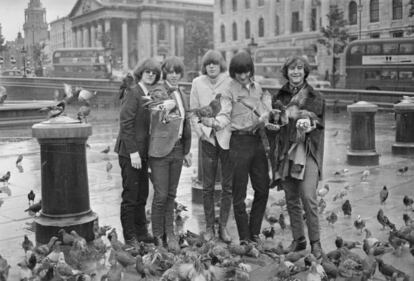Crystalline guitars, yearning voices

Strictly opinion pieces that reflect the author's own style. These opinion pieces must be based on verified data and be respectful of individuals, even if their actions are criticized. All opinion columns by individuals outside the EL PAÍS editorial team will include, after the last line, a byline—no matter how well-known—indicating the author's position, title, political affiliation (if applicable), or main occupation, or any that is or was related to the topic addressed.

Sixty years ago, one of pop's most glorious—and fleeting—subgenres emerged. The Byrds' Mr. Tambourine Man reached number 1 in several countries, fusing folk melodies with the electric instrumentation of rock. Enigmatic lyrics, twanging guitars, and devout vocals. Folk-rock was born.
Or not. The formula had precedents, in groups like the Beau Brummels from San Francisco or the Searchers from Liverpool. The latter were credited with discovering the enveloping sound of the 12-string guitar (later, they acknowledged it was the interplay of two six-string guitars). In reality, it would be better to explain it as a sociological earthquake: many clever kids from folk clubs were knocked out by the Beatles and decided it seemed more fun to play rock.
The initiative was more revolutionary than we can now imagine. Roger McGuinn, leader of the Byrds, recounts that they invited Dylan to hear his rendition of Mr. Tambourine Man , and the author didn't recognize his song (but we know Bob has a peculiar sense of humor). In fact, Dylan had already been recording half of the track " Bringing It All Back Home" with electrified instrumentalists for months.
Simplified, it was a straightforward formula. Dylan's producer, Tom Wilson, used several of Dylan's own musicians to dress up an overly serious denunciation of alienation, recorded by a pair of aspiring folkies . That's how Simon & Garfunkel landed their first hit, The Sound of Silence .
And through those gaps, everyone slipped in. Genuine rock groups like the Lovin' Spoonful, Buffalo Springfield, Jefferson Airplane, the Grateful Dead, the Leaves, and Love. Fresh converts like the Dillards, the Mamas & the Papas, and the Rising Sons (with Taj Mahal and Ry Cooder), plus astute opportunists like P.F. Sloan, Sonny Bono, and Scott McKenzie. Singer-songwriters who agreed to add more or less orchestral arrangements: Fred Neil, Tom Rush, Tim Hardin, and Tim Buckley. And the queens of folk: Judy Collins and Joan Baez. Even 1950s figures like Bobby Darin and Dion got a second chance. Specialized record labels like Elektra and Vanguard made a killing. Heck, even the Beatles assimilated the influences of their Californian disciples with the dazzling "If I Needed Someone ."
The phenomenon crossed the Atlantic. It caught on in the United Kingdom, where they remembered the example of the Animals , who dramatized a ballad of doom known as The House of the Rising Sun. It is true that the British had a robust folk tradition, although it is worth remembering that the first incarnation of the emblematic Fairport Convention leaned more towards San Francisco rock. Surely the one who benefited most from the open-mindedness was a Dylanita, Donovan, recycled into the pied piper of flower power with Mickie Most's productions. The crossover sound also took root in France, Italy, and Spain.
How did folk-rock dissolve so quickly? I suspect it transformed into psychedelic rock, and, as the pendulum swings, so much passion for acid facilitated the shift toward country rock (which is also where The Byrds ended up). Still, it's a treasure worth exploring. There are two compilations on the Cherry Red label that make the task easier: "When Will They Ever Learn?" and " Jingle Jangle Morning." Succulent. both .
EL PAÍS





